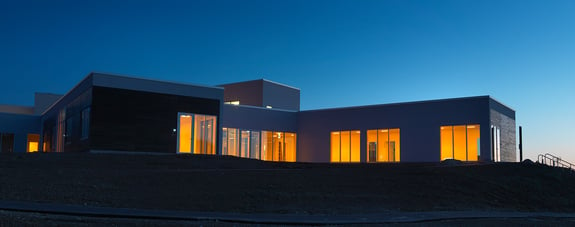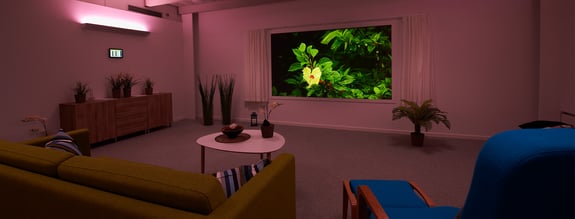
CHROMA ZENIT
CLINICAL STUDIES
PATIENTS
RIGSHOSPITALET GLOSTRUP
The Stroke Unit at Rigshospitalet Glostrup has been conducting research since 2013 on the effectiveness of Chromaviso Circadian Lighting on 90 patients admitted for rehabilitation for more than two weeks, in relation to various factors such as fatigue, sleep, depression, anxiety, recovery, circadian markers, cognitive abilities, and more.
The following results have been published by Ph.D. doctor Anders West in collaboration with an interdisciplinary expert group:
- Reduced depression - significance
- Reduced fatigue - significance
- Reduced anxiety - significance
- Improved circadian rhythm according to markers cortisol and melatonin - significance
- Improved wellbeing - significance
Read more about the results here or watch clips from TV2 news about circadian lighting and depression.
The Journal of Doctors has also published the results - read it here.
— In the future, circadian lighting should be considered as part of the treatment environment.
- Anders West, doctor, Ph.D. Rigshospitalet
PATIENTS
AARHUS UNIVERSITY HOSPITAL
Since 2013, the Neurosurgical Intensive Care Unit at Aarhus University Hospital has been conducting research on the impact of Chromaviso Circadian Lighting as a comprehensive care environment that incorporates light, sound, information screens, and observation. This research focuses on factors such as sleep, agitation, memory, and length of hospital stay.
Learn more about the project's background here.
Preliminary observations regarding the impact of Chromaviso's circadian lighting reveal that patients experience a sense of calmness during nighttime, reduced agitation, and minimal disruption due to the various light settings offered by the lighting concept, all while allowing the healthcare staff to carry out their caregiving tasks around the clock.
- Leanne Langhorn, Clinical Nursing Specialist, Ph.D, Aarhus University Hospital
STAFF
RIGSHOSPITALET OG AARHUS UNIVERSITY HOSPITAL
The two departments at Rigshospitalet and Aarhus University Hospital have collaborated on a pilot study investigating the effects of Chroma Zenit Circadian Lighting on staff members. The study focuses on nurses with rotating shifts and found that circadian lighting has a positive impact on sleep, restfulness, and work environment.
The results were published in May 2018 at the National Neuroconference.
Read the article about the findings here.
In this TV2 clip, you can explore and hear more about the research and its initial indications. Watch it here.
The staff notes that they feel less tired during their shifts and have more energy.
- Helle Iversen, Clinical Research Leader, Physician, Rigshospitalet
ROOM-LIGHT
COPENHAGEN PSYCHIATRIC CENTER, DTU PHOTONICS, AND COPENHAGEN TRIAL UNIT
The project, known as ROOM-LIGHT, is led by Clinical Associate Research Professor and psychiatrist, Klaus Martiny, from Rigshospitalet. It is a collaborative effort between clinicians, researchers, and lighting experts, with the aim of developing and documenting a therapeutic light concept to enhance the treatment of patients hospitalized with depression. This concept aims to improve factors such as hospitalization duration, medication usage, faster recovery, depression severity, sleep, and tolerability.
The project has been awarded the UNESCO Year of Light Innovations Prize for being the most innovative and promising project.
Based on a preliminary study, the project demonstrates a clear correlation between hospitalization duration and sunlight. Read more about the project here.
OTHER CLINICAL STUDIES
Groundbreaking research findings are now prompting the emergency department at Valen Hospital in Norway to introduce circadian rhythm lights for bipolar patients. These lights are tailored to individual treatment plans, and the initial experiences have been overwhelmingly positive.
Circadian lighting has proven to be an effective treatment for hospitalized patients and individuals with dementia. However, a new research project is now focusing on the importance of implementation and how the lighting affects healthcare personnel.
The Lightel project is a clinical controlled study conducted at Albertshøj Plejecenter. This groundbreaking research examines the impact of Chroma Zenit Circadian Lighting on various aspects of health, including sleep quality, mobility, and more. Building upon the knowledge developed by renowned institutions like Rigshospitalet, this study aims to shed light on the transformative potential of this innovative lighting solution.
PRACTICAL EVIDENCE
EVALUATION REPORT: CIRCADIAN LIGHTING IN PSYCHIATRY
Region Syddanmark, CoLab Health & Rehab:
Aabenraa Psychiatry
The report was conducted by CoLab Recovery & Rehab and Region Syddanmark, offering a comprehensive evaluation of the circadian lighting system in the region's three psychiatric departments, provided by various suppliers. The objective of the report is to uncover the perceived impact of the circadian lighting on both employees and patients, while providing an overview of the overall experience within each department and across departments.
The findings of the report were made public on January 20, 2017, revealing the following insights:
- Both employees and patients have evaluated that the Chroma Zenit Circadian Lighting system has a significant impact in promoting natural sleep patterns and sleep quality. It provides a comfortable environment, creating a sense of calm and a cozy atmosphere in the evening.
- The Chromavisos Aabenraa installation has received high praise for its implementation and the remarkable satisfaction and effectiveness it has had on sleep and well-being.
- Additionally, Chromavisos' blue-free night light is recommended due to its positive effects on sleep, light quality, and color rendition.
The report can be found on the website of Region Syddanmark.
Watch a clip from TV Syd here that summarizes the impact of circadian lighting. The clip was filmed in Aabenraa and showcases the effectiveness of the lighting system.

DEMENSCENTRUM AARHUS
Aarhus Kommune
DemensCentrum Aarhus is actively working with stimuli in a new combination of light, sound, and images to calm agitated dementia patients. Results from the analysis of the use of the new Stimuli Room show that the sensory-stimulating light makes a significant difference in terms of:
- Improved mood
- Increased alertness and activity levels
- Impact on angry and outwardly expressive individuals
- Effect on individuals with physical and mental restlessness
- Effect on individuals seeking exit
- Effect in relation to sleep problems
- Enhances presence and joy

LOCAL CENTER SØNDERSKOVHUS & CENTER FOR FRIHEDSTEKNOLOGI
Aarhus Kommune
Sønderskovhus Local Center has successfully implemented Chroma Zenit Circadian Lighting in 12 nursing homes, the dining area, the living room, and several activity rooms. In April 2016, a user survey was conducted among the staff members who regularly work in the circadian lighting.
Thirteen staff members responded to the questions, and the results revealed the following:
- Staff members are extremely satisfied and eager to recommend it to others. They experience reduced fatigue, increased energy, a greater sense of calm, and less mental fog.
- The various lighting settings provide immense value, as they are frequently used by all staff members to soothe and create a sense of security.
- There is a positive impact on the residents as well, with staff members noticing decreased aggression, less nighttime wandering, improved sleep, a better appetite, and increased energy levels.
- The user-friendly controls are accessible in all rooms, and staff members appreciate the ease of operation and the ability to control the lighting from anywhere.
- The night lighting is highly regarded, as night shift workers can see clearly, read and write comfortably, and find solace in the ambiance it creates. It promotes a sense of security, calmness, and encourages softer speech. Additionally, two out of three staff members find it easier to fall asleep after completing their night shift.


